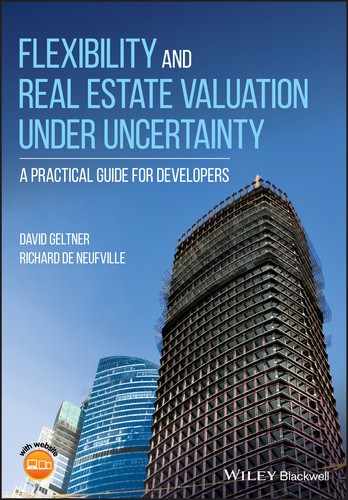15
Timing Options in Development: Now we Turn to the Types of Timing Options
Broadly speaking, timing options are more common in development projects than are product options. Almost all development projects have at least some basic type of timing option. Here, we consider three types of timing options. For purposes of conceptual understanding, and to build your analytic intuition, the timing options we consider here effectively take the product as given. It is useful to distinguish relatively “pure” types of options. In reality, timing options will, of course, often exist simultaneously with product flexibility.
After discussing the types of timing options, this chapter concludes with a demonstration of how one can characterize options as defensive or offensive by what they do to the shape of the cumulative and frequency target curves in the results of a Monte Carlo simulation.
15.1 Project Start‐Timing Flexibility (The Delay Option)
In Section 12.2, we introduced the most basic and common type of timing option in real estate, the call option on development that resides in land ownership. From the perspective of land valuation presented in Chapter 12, fee simple or freehold ownership of land provides the right without obligation to develop the land at any time in perpetuity (contingent on planning permissions, of course).
In principle, the landowner has flexibility to start the project at any time. As with all options, the start‐timing option for a project faces a favorable asymmetry in its future payoffs (“all gain, no pain”). As long as the landowner/developer has not yet triggered the option (has not started development), he or she can either take advantage of upside realizations in the real estate market by starting the project in such good conditions, or can wait out downturns before starting the project.
Although the start‐timing option is essentially a call option on the construction of a property asset, we can view it as a delay option on the development project. From the perspective of the developer, flexibility in starting a project often involves delaying from an initially planned start date.
In practice, developers need to do a lot of preliminary work before they can start a project, more so with more complex projects. The preliminary work may include assembling several land parcels and purchasing or gaining control of the site. They must also get the project designed and specified, first at a broad level and then in more detail. They may need planning permission, approval of zoning changes, and various other permits. They then have to put construction documents out to bid, and line up construction financing. All of this requires significant time and money, so the developer typically views the date of completion of such preliminary work as the planned start date for the project.
In reality, however, the preliminary work in most cases does not require developers to start construction immediately when the preliminary work is complete. To some degree (and with more or less planning and enabling), the start date can remain flexible beyond the initial first possible (and likely planned) start date. The longer the delay, the more effort that the developer must make to maintain the viability of the specific plans for the project. However, in principle, the delay can be virtually indefinite in many cases, if delay makes economic or other type of sense.
Delay may indeed make sense if the market conditions are not currently as good as when the developer envisioned and planned the project. In this case, the delay option is effectively a defensive option. It allows investors in the project to reduce their losses during a downturn. This is typically the realistic, practical nature of flexibility in starting projects. This is why developers usually view (and refer to) it as the “project start‐delay option.” In fact, it is essentially the same thing as the development call option that we introduced in Chapter 12. But, as we have seen, options can be viewed from two perspectives—the option “to do” something, or the option “to not do” it.
15.2 Project Production Timing Flexibility
Real estate development projects create products in the form of one or more building structures. Once the development project has started, there may exist various ways and approaches to vary the timing of the production of this output. There will generally be an initially planned production schedule, a base plan. Production timing flexibility is the ability to deviate from this base plan.
If the project is simply to produce one building, then there may not be much flexibility in the production timing. Most easily, it may be possible to vary the speed of the construction. Builders could increase or decrease overtime work, or include construction at night or in cold weather, or not, with a trade‐off in terms of cost and completion date. But once started, it rarely makes economic sense to stop the construction of a single building, except in extreme cases, especially for large buildings. In such cases, owners will sometimes pause construction after the foundation is complete, or temporarily “cap” one or two stories of a high‐rise to await conditions more desirable for completion. For example, following the 2008 financial crisis, Harvard University capped its billion‐dollar project to build a new science complex, and did not resume work until about 7 years later (see Figure 15.1).
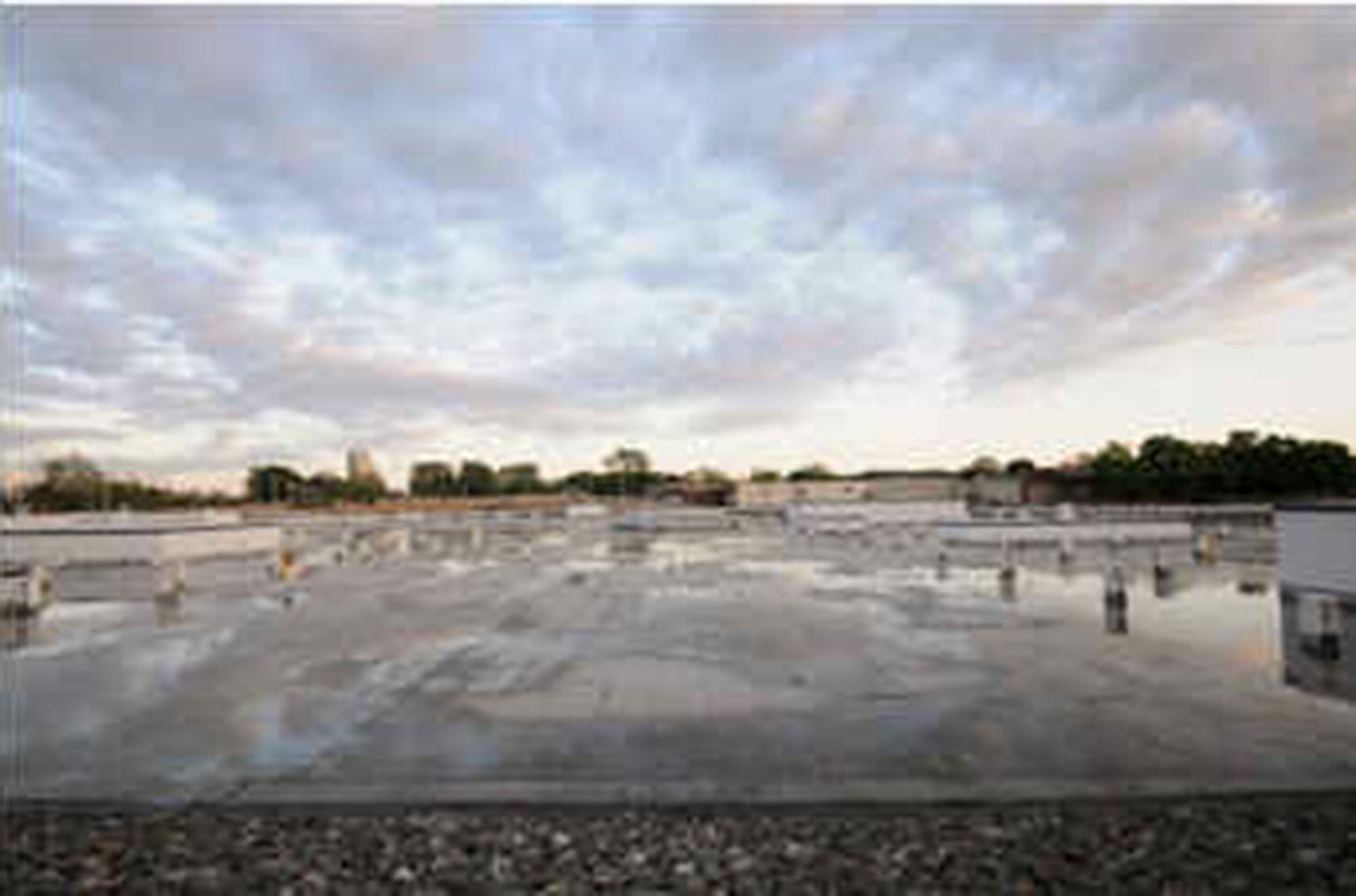
Figure 15.1 Harvard University’s Allston Science Complex, delayed 6 years.
Source: The Crimson, June 14, 2012 (https://s3.amazonaws.com/thumbnails.thecrimson.com/photos/2012/06/14/113909_1277855.jpg.800x530_q95_crop‐smart_upscale.jpg).
In the case of multi‐building development projects, ranging from tract housing developments to large residential or mixed‐use projects, there is often much more scope to modulate the rate of production of the buildings after the overall project has been started. In effect, developers can delay the full buildout or completion of the project beyond the originally planned production schedule (or, in some cases, accelerate it ahead of the original schedule). Viewed from the perspective of the base plan schedule, such production timing flexibility represents an option “in” the project. If it involves only the ability to pause the process or stretch out the time to construct the project, thereby delaying the completion (possibly even ultimately abandoning parts of the project), then we would consider this a purely defensive type of flexibility, cutting the losses or reducing the magnitude of investment costs exposed to loss. If the production timing flexibility also involves some ability to accelerate the project, then we could view that aspect as an offensive option, enabling the profiting from earlier or better‐than‐expected demand conditions.
While the variety of types of production timing flexibility in the real world is potentially very rich and nuanced, we focus in depth on two somewhat stylized and archetypical types: modular production and phasing.
- Modular production means that, in principle, the developers can pause and restart projects where they left off, at any time, effectively anywhere in the project.
- Phasing means that the project contains two or more phases, with some flexibility in the start times of at least one of the phases.
Modular production would generally provide much greater timing flexibility than project phasing. But the two types of flexibilities are not necessarily mutually exclusive. A given phase could contain some modular production flexibility. But, in the pure cases, to distinguish for analytical purposes, modular flexibility means there is no need for phasing, and phasing would not envision being able to pause or leave incomplete any phase once its construction has begun.
15.3 Modular Production Timing Flexibility
With modular production, the idea is that, once developers have started a project, they can stop or pause it (or some phase of it) at almost any point, and then may resume it later from that point. They may also be able to permanently abandon the project at the stop point. Modular production timing flexibility requires some specialized design and planning for the project, and will not be possible in all multi‐building projects.
An example of modular production timing flexibility is a large tract housing development built consecutively on a contiguous grid pattern, which is serviceable for any scale of project completion. The developer would neither pave streets nor sell lots in the next block until buyers had bought up the previous blocks. Modular production flexibility would mean that the developer could decide not to sell any units in a given year, but then could resume the original schedule in any subsequent year. Developers must usually build some amount of infrastructure at the beginning of the project in order to enable at least a portion of the overall project to proceed to buildout (see Box 15.1).
Modular production seems most feasible “horizontally,” applying to buildings or groups of buildings. But modern design and construction techniques offer some possibilities for “vertical” modular production. These make it possible to build out the scale and configuration of an individual building with flexibility in the timing of completion. (For example, there are techniques for inserting “pods” into a building frame.)
15.4 Phasing Timing Flexibility
“Phasing” (or “staging”) flexibility differs from modular production in two important respects:
- First, the overall project is divided into just a few discrete, substantial physical parts;
- Second, developers should complete each phase once they start it.
Large developments typically only have two or three “phases” or “stages,” although very large projects can have many more. Each phase consists of certain planned buildings, together with their related infrastructure and grounds. The phases may be quite different from one another, or very similar. The key point is that each phase represents a largely self‐contained development project in itself. Once the project has completed a phase, that phase can operate at full, or at least normal, rates of productivity or serviceability.
For example, a first phase might include a first series of houses, or apartment blocks, or a parking garage linked to a hotel and office building. Second and possibly subsequent phases might simply be more of the same, or they might include different real estate products that are complementary to the previous phase(s), such as condominiums or a shopping center.
The second defining characteristic of a “phase” as distinct from modular development is that, once developers have started to build a phase, they pretty much have to complete it. A phase is an integrated complex that cannot function well unless it is all there.
Phasing thus does not provide as much production timing flexibility as pure modular development. This is because the phases are discrete or “lumpy,” and must be completed once started.
The distinction between phasing flexibility and the expansion options described in Chapter 14 can be fuzzy in practice, but it is meaningful at a conceptual level, and useful for design and planning purposes and analytical consideration. It can allow us to gain insight about the value of project flexibility. We noted that the key distinction in principle is that the expansion option is not part of the base plan, and is not as likely to be realized, at least not in the foreseeable near‐ to medium‐term future. Another important difference between project phasing and expansion options is that the latter require some early investments to enable the expansion option. The creation of an expansion option requires an upfront investment, either in additional land or in structural strength and other physical design requirements of the building. Phasing, on the other hand, usually does not require any upfront cost. It is simply a way of designing, organizing, and programming the production of the base plan.
15.5 Types of Phasing
Phases within a project can be either parallel or sequential in their temporal relationship with each other. By definition, developers can build parallel phases in any order, or simultaneously. They are not temporally dependent. An example might be “Housing Block A” and “Housing Block B” fronting roads providing simultaneous access to both sites. The developer might choose to build both phases simultaneously if the housing market is very strong, making it likely to sell the combined quantity of houses sufficiently quickly. Or, the developer could choose to first build Housing Block A and hold off on starting House Block B until later (or vice versa). This would be prudent if the housing market seems just strong enough to absorb rapidly only one of the two phases’ buildings.
With sequential phases, on the other hand, there is a temporal order and dependency between the phases. We cannot start “Phase 2” until we have at least started “Phase 1” and have taken it to some stage of completion. Perhaps we cannot start Phase 2 until Phase 1 is physically complete, or possibly near full operation. (The former situation suggests physical dependency, while the latter suggests economic dependency.) A physical reason for sequencing might be that you can’t get to the site of Phase 2 until at least the infrastructure of Phase 1 is complete. An economic reason might be that a planned retail center may not be viable until the surrounding housing units fill up and provide the necessary market for the retail center.
In terms of analysis and valuation methodology, parallel and sequential phases require different approaches. We should model:
- Parallel projects either as separate, independent projects, or else as horizontal expansion options; and
- Sequential phases as compound options—that is, options on options. We show how to simulate sequential phasing in Chapter 22, in which we explore the phasing option in more depth with a numerical example.
15.6 Recognizing Defensive and Offensive Options in Simulation Results
Offensive and defensive options each lead to different types of results in terms of their impact on the nature of the risk and return performance faced by investors in the project. The difference shows up dramatically in simulation analysis, in the shape of the target curves representing the distribution of possible future performance outcomes of investments.
As we described in Chapter 8, target curves provide a useful way to visualize the output from a Monte Carlo simulation. They depict either the cumulative or frequency distribution of the simulation results for a metric of interest to investors, such as NPV or IRR.
The target curves output by a simulation typically reveal interesting characteristics of the types of flexibilities that we have been describing. Most notably, the way the flexibility affects the shape of the target curve reveals the extent to which it is essentially a defensive or offensive option (or perhaps both). With the target metric on the horizontal axis (such as NPV or IRR), and probability on the vertical axis, defensive options truncate the left‐hand tail of the target curve—they cut the downside. Conversely, offensive options extend outward to the right the right‐hand tail—they boost the upside. Either of these changes will work to increase the mean of the distribution of possible outcomes—in effect, the ex‐ante mean. A pure defensive option, such as a delay option, which only truncates the left‐hand tail, will also reduce the standard deviation or dispersion in the possible project outcomes, which is usually viewed as reducing the investment risk (particularly when the target metric is the IRR).
The timing options described in this chapter largely tend to be defensive. The product options described in the previous chapter tend to be more offensive. Some types of flexibilities, such as the product mix flexibility described in Section 14.3, can move the entire target curve to the right. (Recall that the product type switching option can be viewed simultaneously as a call on one alternative and a put on the other.)
Using generic output from an example simulation, we can illustrate the characteristic differences in target curves between defensive (put) and offensive (call) options. Figures 15.2a and 15.2b indicate call option type flexibility as seen in both the cumulative and frequency target curves (for the same simulated outcomes). Figure 15.2a is the cumulative curve, and Figure 15.2b is the frequency curve. You see how the call option shifts the performance distribution to the right in the better outcomes, increasing the chance of better outcomes, making greater upside possible for the project.
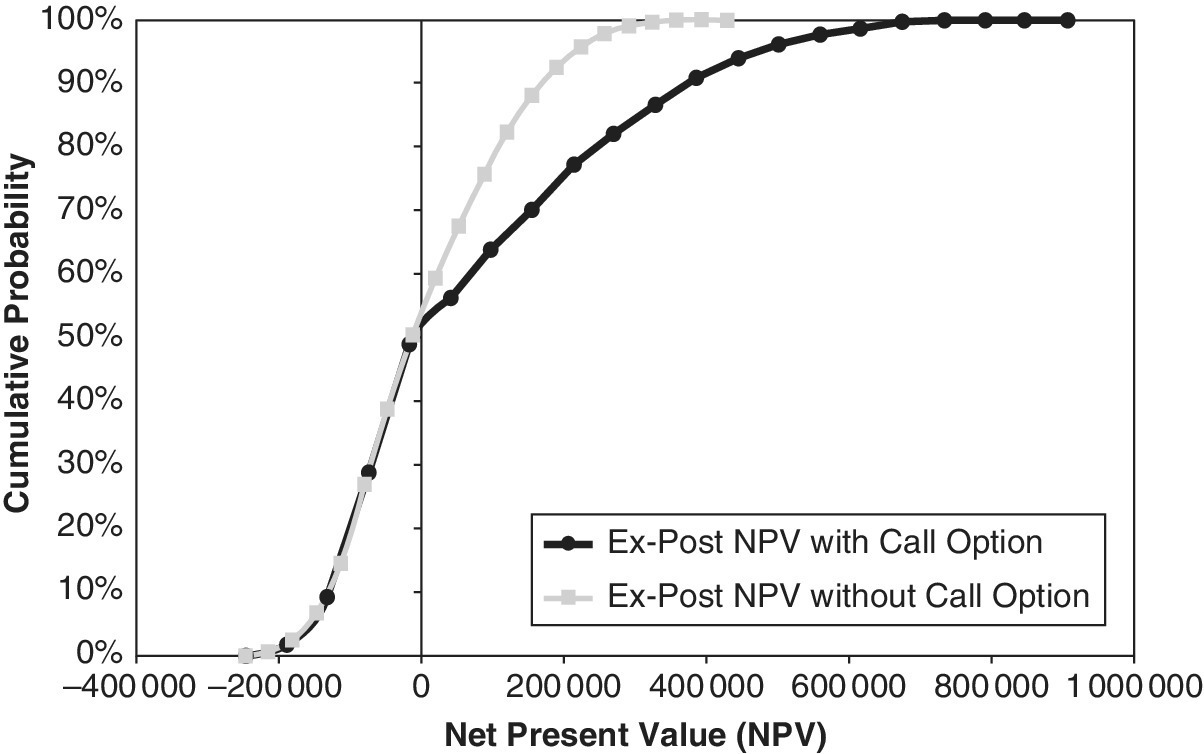
Figure 15.2a General effect of “call” options on development project as seen in cumulative target curves.
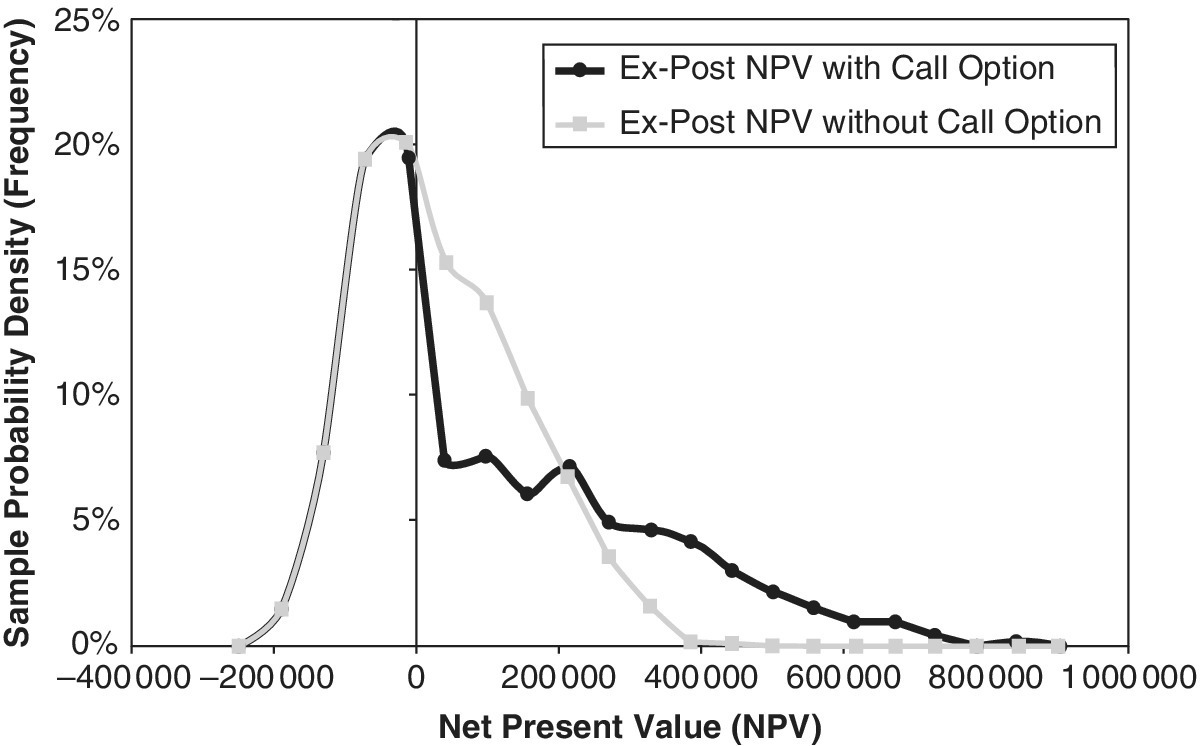
Figure 15.2b General effect of “call” options on development project as seen in frequency target curves.
Complementarily, Figures 15.3a and 15.3b indicate put option type flexibility, again seen in both the cumulative and frequency target curves. Here, you can see how the put option protects and chops off the downside, shifting the left‐hand tails of the curves to the right. Defensive flexibility enables performance outcomes in the downside scenarios that are not as bad as without flexibility.

Figure 15.3a General effect of “put” options on development project as seen in cumulative target curves.
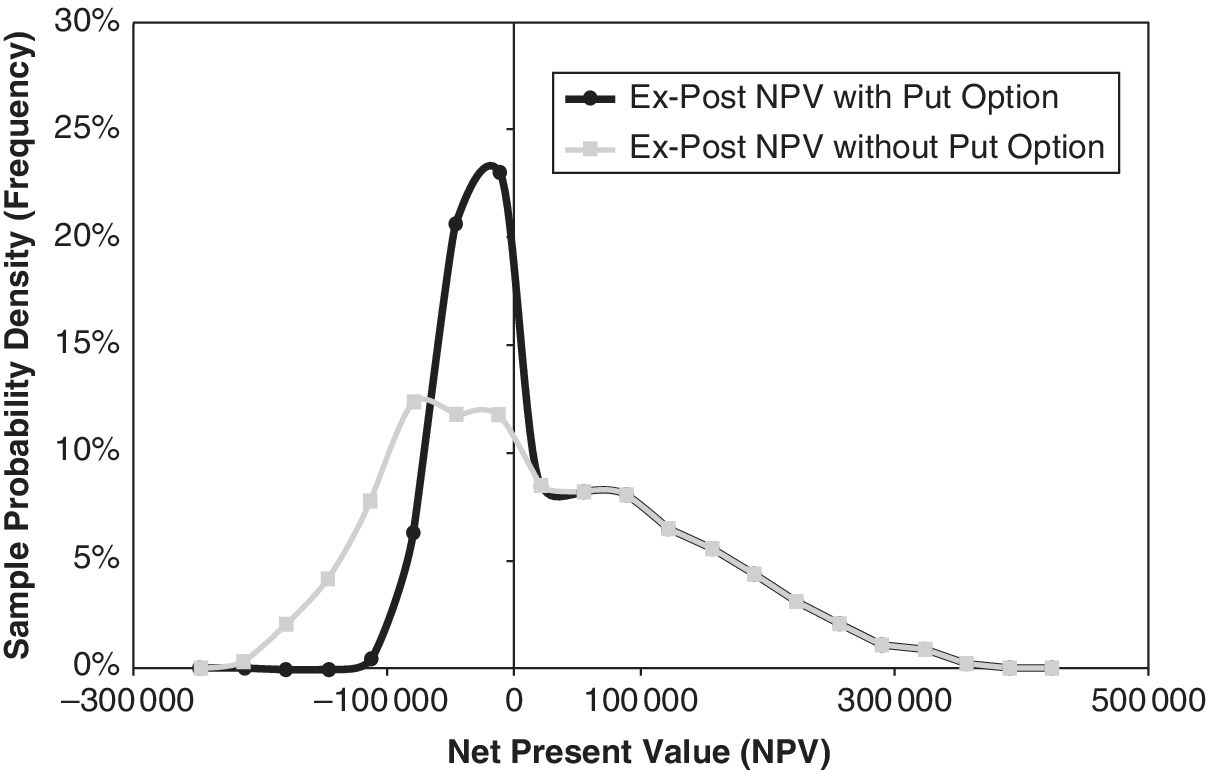
Figure 15.3b General effect of “put” options on development project as seen in frequency target curves.
15.7 Conclusion
This chapter presented the several types of timing flexibility in development projects: start delay, modular production, and phasing (in both parallel and sequential forms). It sets the scene for our demonstration in the remaining chapters of how we can analyze each of these types of flexibilities.
We also suggested some perspectives that can be incisive for building useful intuition about flexibility, including how target curves of investment performance produced by simulation analysis can explain the concept of defensive and offensive options.
In the following chapter, we will introduce an example development project, patterned on an actual project in the real world, that will allow us to demonstrate, at a more concrete and realistic level, how we can simulate real estate development project flexibility value for the various types of options described in this and the preceding chapters.
